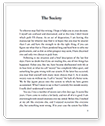Essay Instructions: This is a Literary Analysis Paper
The only source that should be used is what is in Beowulf
No you or I
Go beyond the obvious: The paper should not a be a summery of the work, nor should it merely give a shallow, "face-vaule" interpretation of the work example: (Shakespeare's sonnest are about love this is a shallow approach) An excellent paper will discover and explain aspects of the work that are not immediately apparent on a first reading.
Use evidence well: You shoud quote directly from the work in your paper. These quotes should be introduced, explained, and linked to the larger arguement of your thesis. Like a scientific lab report, your paper must back up its claims with evidence. Assertions, even if accurate and insightful, will be worth little unless they are supported by examples drawn from the work and/or from the work's social and historical context. Nonetheless, don't let quotes comprise more than about 25% of your paper
Be-well-organized: An excellent paper will have an interesting introduction and a thoughtfull conclusion. A clear, debatable thesis should be presented early in the essay, and the body of the paper should follow the structure suggested by the theses. The body paragraphs, as a group, should provide support for the thesis and, within themselves, should each focus on a single topic.
Have an appropriate style and tone: Think of your professor and peers as your audience. The paper should a have a formal tone appropriate to serious academic discourse. In this context, logical arguement and analysis are privileged over subjective, or personal impressions. Thus, while a work may have affected you deeply, your reaction should not be the focus of the paper. You may analyze what in the work provoked your reaction, but your focus should be primarily on the literature.
Focus on the text: Your purpose in this paper is to show that you understand the text and how it works to convey meaning. As stated in the previous point, your focus should be primarily on the literature. be careful that the theme of the work doesnt become a topic of its own. For example, dont use Beowulf as a platform from which you can talk all about the need for courage; rather, let the paper be a platform for Beowulf to teach us about courage.
If you choose to compare two or three works in the anthology rather than foucs on one work, make sure that the works you choose have some significant similarities, a common ground, and make thos similarities the focus of your paper. A good comparison/contrast paper will look at two works together in order to intensify and increase the reader's understanding of something the works have in common. Comparison/contrast papers can also be used constructively with the historical approach example (two time periods views on the roles of women)
Formal strategies focus on the literary elements and techniques such as character, theme, setting, symbol, rhyme, meter, etc. The emplasis here is on how the work is crafted and put together. A successful formalist paper shows how the poem or story "works" how all pieces come together to create a certain effect in the reader. Little attention is paid to "exterior" matters.
Biographica strategies investigate how the author's life influenced his or her writing. Often, knowledge of the author's life gives a new perspective on passages in the text, as the author uses fiction to work through issues in his or her own experience.
Historical strategies emphasize the social context within which the work was written. Like biographical strategies, this approach uses history and society to illuminiate hidden meanings within the text. Thus, a story about a family may serve as a parable for the struggles society as a while is going through, at the time the story was written.
Marxist strategies are a subcategory of historical criticism. They foucs on the soical context of a work with an emphasis on how class structues and economic circumstances control characters' actions. Works that emphasize the artificial barriers created by society are good candidates for this type of criticism.
Gender strategies blemd fromal and historical concerns as they study the work's treatment of men and women. Usually, this strategy tries to show that the author has used the play to send a message about how men and women treat each other.
Mythological strategies look for universal symbols, often called archetypes, in a work. By pointing out symbols and motifs which have deep roots in human consciousness---water, resurrection, the quest---mythological strategies often find important connections between works that, at first glance, seem unrelated.
Psychological strategies try to discover what motivates a character to act. These motives are often unknown to the character herself. In other words, an interesting psychological analysis shows that while a character may claim to act for a certain reason or purpose, the story reveals that other experiences, attitudes, and emotions actually motivate him/her.


